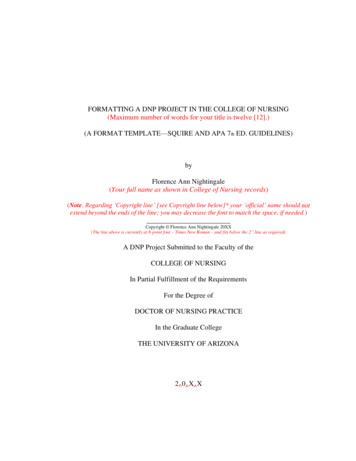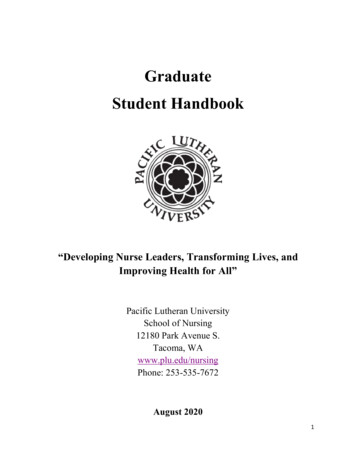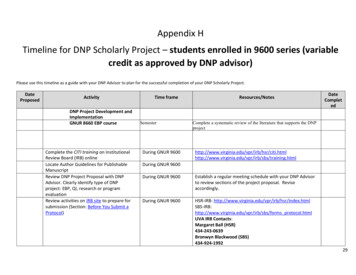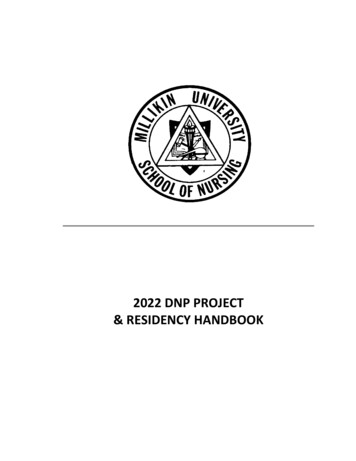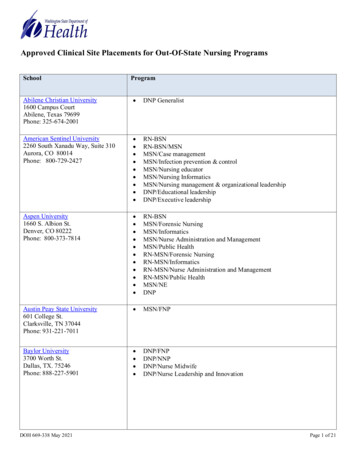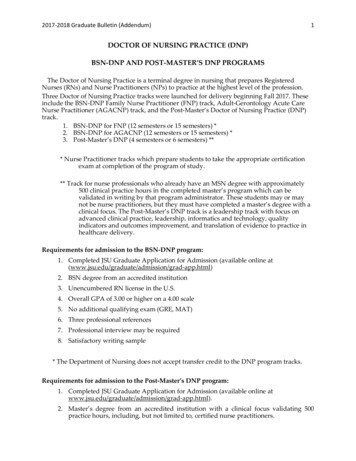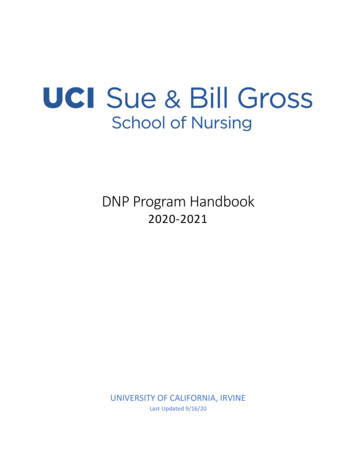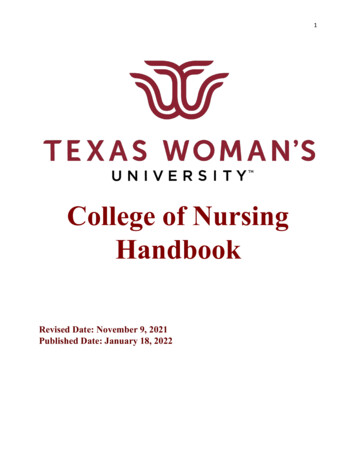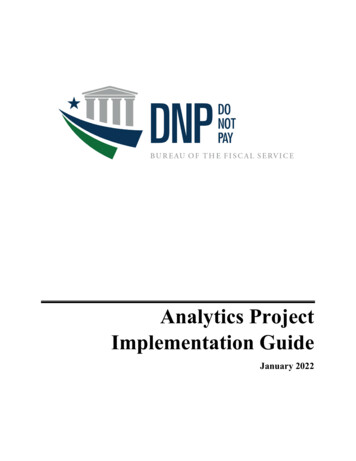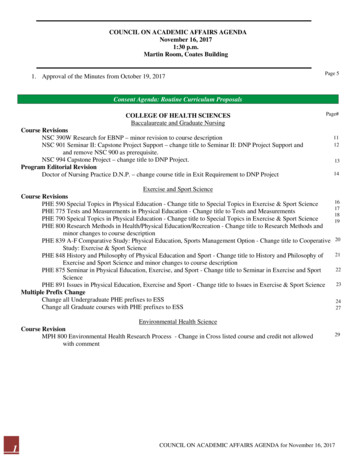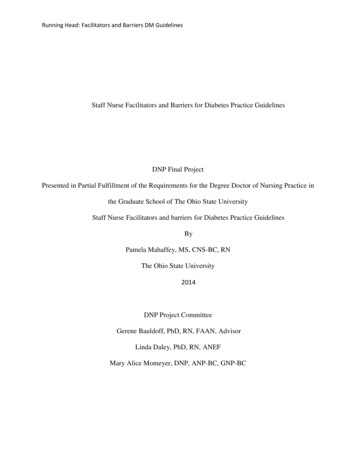
Transcription
Running Head: Facilitators and Barriers DM GuidelinesStaff Nurse Facilitators and Barriers for Diabetes Practice GuidelinesDNP Final ProjectPresented in Partial Fulfillment of the Requirements for the Degree Doctor of Nursing Practice inthe Graduate School of The Ohio State UniversityStaff Nurse Facilitators and barriers for Diabetes Practice GuidelinesByPamela Mahaffey, MS, CNS-BC, RNThe Ohio State University2014DNP Project CommitteeGerene Bauldoff, PhD, RN, FAAN, AdvisorLinda Daley, PhD, RN, ANEFMary Alice Momeyer, DNP, ANP-BC, GNP-BC
2AbstractIntroduction: The management of diabetes and achievement of blood glucose goals forhospitalized patients is complex due to numerous variables. National guidelines with an intraprofessional approach have been developed and include blood glucose goals as well as the use ofscheduled basal and pre-meal insulin dosing (Umpierrez, et al., 2012). At Grant Medical Center(GMC), protocols have been developed and implemented to incorporate the national guidelineswith the leadership of an intra-professional diabetes care committee.Methods: This project used a focus group discussion format to assess nurse perceptionsof the national guidelines as well as to identify facilitators and barriers for implementation of theguidelines.Results: The overarching areas of facilitators and barriers each included categories ofnurse factors, patient factors, prescriber factors, treatment factors and DM meal factors. Nursesshared that staff education, the availability of diabetes educators and pre-printed ordersfacilitated guideline use; while, the on demand meal process, dietary non-adherence andvariations in prescriber practices were barriers to guideline use.Conclusions: There are gaps in the implementation of national guidelines forhospitalized persons with diabetes. Overcoming the barriers and cultivating the facilitators canimprove care processes and patient outcomes. This project identified areas of opportunity foradditional staff and patient education as well as processes that can be improved, e.g., the ondemand meal process and the pre-printed order sets.
3Chapter One: Nature of ProjectThere are many reasons persons with Type 2 diabetes require hospitalization. Thediabetes can be a primary reason for hospitalization or can complicate the primary reason forhospitalization. In all cases the presence of diabetes creates challenges for the cliniciansproviding care. The purpose of this project is to identify what bedside staff nurses at onehospital setting perceive as facilitators and barriers to the implementation of guidelines for themanagement of hyperglycemia (including diabetes patients) in hospitalized non-critical carepatients. For this project, facilitators are any factors that contribute to adherence to publishednational diabetes guidelines and a barrier is defined as any factor that inhibits the nurse fromfollowing the guidelines (Abrahamson, 2012). The setting for this project will be a 500 bedinner city level I trauma center facility. A maximum of 50 nurses will complete a biographicalquestionnaire and participate in a one hour focus group to discuss what they view as facilitators(positives) and barriers (obstacles) to the implementation of nationally recommendeddiabetes/hyperglycemia management guidelines. Themes for the facilitators and barriers will bedeveloped based on nurse participant feedback.Significance to Nursing and Consistency with Doctor of Nursing Practice EssentialsThe Doctor of Nursing Practice (DNP) essentials provide the foundation and principlesfor competencies of DNP students (Chism, 2013). Furthermore, the DNP essentials are intendedto guide the education of advanced practice nurses to provide the highest level of nursingpractice which is based on science, research, clinical experience and the patient’s perspective(Zaccagnini & White, 2011). This project incorporates the DNP essentials: II, organizational andsystems leadership for quality improvement and systems thinking; III: clinical scholarship andevidenced based practice; and VIII, advanced nursing practice ("American Association of
4Colleges of Nursing," October, 2006). One of the goals for the DNP prepared nurse is to leadand guide the implementation of evidence-based practice (Zaccagnini & White, 2011).Evidenced based practice data from meta-analyses, randomized clinical control studies and otherstudies should guide the practice of nursing (Melnyk & Fineout-Overholt, 2011). For thisproject, evidence is published to support and guide the management of hospitalized diabetespatients and provides the guidance for nursing care (Umpierrez, et al., 2012). The nursing carerecommended in the guidelines is intended to improve patient care and outcomes in diabeticpatients (Umpierrez, et al., 2012). The DNP candidate promotes advanced practice throughinfluencing care and providing leadership for diabetes care at GMC.Project ObjectiveThe PICOT question that guided this project was: What are the facilitators and barriersidentified by staff nurses at Grant Medical Center for the implementation of diabetes mellituspractice guidelines?
5Chapter 2: Literature ReviewFrameworkThe Iowa Model of Evidenced-Based Practice to promote quality care provides themethodology and framework for this project (Appendix A). The Iowa model provides guidanceto nurses and other healthcare providers for clinical decision making to improve patientoutcomes (Titler, et al., 2001).The component of the model for this project is monitoring and analyzing the structure,process, and outcome regarding implementation of the guidelines into practice (Titler, et al.,2001). A national guideline for the management of hyperglycemia for non-critically illhospitalized patients was the knowledge trigger for this project (Umpierrez, et al., 2012). Thisguideline incorporates a multidisciplinary approach and nursing activities with the aim ofproviding evidenced based care. The implementation of evidenced-based practice guidelines formanaging hyperglycemia, including patients with diabetes was seen as a priority for the hospital,Grant Medical Center (GMC). An interprofessional diabetes care committee was formed, thediabetes guidelines were piloted on one nursing unit and the decision to implement them hospitalwide was recommended. This project incorporates the component of the Iowa model whichaddresses instituting a change in practice based on evidence and the subsequent monitoring ofstaff to evaluate knowledge of care and quality of care (Titler, et al., 2001). An assessment ofstaff nurse perceptions was conducted to determine ways to improve guideline utilization andultimately improve patient outcomes. The findings as described in the Iowa model are intendedto provide insights and opportunities regarding the implementation of evidenced-based practiceof guidelines for management of diabetes in the in-patient setting and subsequently contribute toimproved quality of care and improved patient outcomes (Titler, et al., 2001).
6Diabetes Mellitus (DM)Diabetes mellitus is a chronic health disease affecting 18 million Americans (CDCDiabetes, 2012). The presence of diabetes related co-morbidities including hypertension,atherosclerosis, peripheral vascular disease and renal disease contribute to the need for repeatedhospitalizations for many diabetics; furthermore, individuals with diabetes account for 30% of allhospitalized patients (Draznin, Gilden, Golden, & Inzucchi, 2013). The stress of illness cancontribute to hyperglycemia; and severe hyperglycemia or episodes of hypoglycemia cancontribute to an increased length of stay, increased health care costs and poor patient outcomes(Deno & Schaper, 2011). The management of diabetes is complex; however, the UnitedKingdom prospective diabetes study with type 2 diabetics a landmark trial demonstratedimproved patient outcomes when glycemic control is achieved and maintained (UKPDS StudyGroup, 1998). Studies that examined the effect of tight blood glucose control in the noncritically ill hospitalized patient population also demonstrated a decrease in infection rates andno increased incidence of death or myocardial infarction or stroke (Murad, et al., 2012). Inaddition, the achievement of “glycemic control results in lower rates of hospital complications ingeneral medicine and surgery patients” (Umpierrez, et al., 2012, p. 16.)Self-Management in DMPatients with diabetes must be actively engaged in self-management and self -monitoringactivities; however, during an illness and hospitalization these activities can be disrupted. Thehospitalized diabetic must give up some of their autonomy and rely on others to manage theirdiabetes. Additionally, individuals may have fears about taking insulin and experiencinghypoglycemia and may not fully comprehend the diabetes treatment plan. Also, persons with
7diabetes are at risk for depression and psychosocial issues which can affect glycemic control forthe hospitalized patient (Rubin, Peyrot, & Siminerio, 2006).It is important to include family members in the diabetes treatment plan so that they canbe knowledgeable and supportive in the diabetes management process (White, et al., 2009).Family members and visitors must be educated about bringing in foods and snacks tohospitalized diabetics as these can be contributing factors of poor glycemic control.Guidelines for Inpatient Management of HyperglycemiaHealth care providers need to be actively engaged with their patients to successfullymanage diabetes and achieve treatment goals. Good diabetes management requires significanttime, knowledge and commitment to assist patients to achieve glycemic control (Munoz, et al.,2012). Many clinicians have been trained to use sliding scale insulin coverage to manageglucose levels; however, evidence suggests that a basal and prandial dosing schedule is preferredto achieve good glycemic control (Draznin, et al., 2013; Munoz, et al., 2012; Umpierrez, et al.,2012). In addition, some clinicians are reluctant to initiate or administer insulin because of theirperceived increased risk of hypoglycemia (Hauber, Mohamed, Johnson, & Falvey, 2009).Blood glucose levels during hospitalization have revealed that 40-67% of patientsexperience hyperglycemia (blood glucose above 180 mg/dl) (Solis, Hurtado, Demangel, & Soto,2012; Torres-Torres, Maldonado-Rodriguez, Perez-Lopez, Sierra-Martinez, & Garcia, 2011). AtGrant Medical Center, seventy five percent of patients that have bedside glucose monitoringorders have blood glucose levels above 200 mg/dl during hospitalization. Hyperglycemia above300mg/dl and hypoglycemia below 70mg/dl in the non-critical care adult are known tocontribute to increased length of stay and cost (Solis, Hurtado, Demangel, & Soto, 2012).
8Guidelines for the management of non-critically ill hospitalized persons withhyperglycemia (including diabetes and non-diabetes related hyperglycemia) were developed toprovide recommendations for these patients and include both medical and nursing interventionsthat are intended to improve patient outcomes (Umpierrez, et al., 2012). The goal for bloodglucose levels during hospitalization is a range of 100mg/dl- 200mg/dl (Umpierrez, et al., 2012,p. 22). The range of 100-200mg/dl was chosen to avoid hypoglycemia reactions as well as toavoid severe hyperglycemia.One of the major components of these guidelines is the recommendation of basal andbolus insulin management for all hospitalized patients which has demonstrated better glycemiccontrol than sliding scale insulin coverage (Umpierrez, Smiley, et al., 2007 & Deno & Schaper,2011). The basal-bolus regimen more closely mimics normal pancreatic function and doses canbe titrated to meet the changing needs of the hospitalized patient without increasing the risk ofsevere hyperglycemia or hypoglycemia (Umpierrez et al., 2012; Deno & Schaper 2011).The guidelines for hyperglycemia management include nursing interventions that areintended to provide comprehensive diabetes care and therefore improve patient outcomes(Inzucchi et al., 2012; Umpierrez, et al., 2012). Key components for nursing care include: 1.administering basal/bolus insulin as prescribed, 2. monitoring patients’ response to treatment, 3.performing and evaluating bedside blood glucose monitoring, 4. assuring meals and snacks areproperly timed with bolus/pre-meal insulin doses, and 5. providing patient and family education(Umpierrez, et al., 2012).Barriers to Diabetes Guidelines AdherenceThere are many reasons that diabetes guidelines are not followed and glycemic control isnot achieved. Glycemic control can be difficult to achieve and is influenced by health care
9provider’s knowledge, training and beliefs (Daly, et al., 2009). At times there is reluctance forprescribers to use insulin because it is time-consuming and there is a greater risk ofhypoglycemia (Hauber, et al., 2009). In addition, nursing or prescriber lack of knowledge orunderstanding contributes to inappropriate holding of insulin and subsequent persistent or moresevere hyperglycemia (Daly, et al., 2009). Hospitalization itself also disrupts normal routines;and, illness, infections, and some medications can negatively impact glycemic control adding tothe complexity of patient management (Draznin, et al., 2013). Furthermore, the diabetesattitudes, wishes and needs study revealed that patient psychosocial issues and financial barriersas well as the poorly equipped health care system in the United States are barriers to achievingglycemic control (Peyrot, et al., 2006).Clinical practice guidelines are intended to help clinicians incorporate knowledge andresearch into practice (Abrahamson, 2012). Internal factors include the nurse/health careproviders’ knowledge of guidelines, attitudes and self-motivation while external factors includethe work environment, awareness of the guidelines, organizational priorities and managementobjectives (Abrahamson, 2012). These internal and external factors can either facilitate adoptionof guidelines or they can be barriers to guideline adoption (Abrahamson, 2012). Patients andproviders may not accept the guidelines and may resist or delay the use of insulin (Nam, Chesla,Stotts, Kroon, & Janson, 2011). Nam, et al., (2011) reviewed 80 studies and identified multiplebarriers for diabetes management including inadequate interventions by healthcare providers andpoor self-management by patients. Nam, et al., (2011) recommended that staff education, moretime, and the availability of diabetes resources, direct feedback and the provision of incentivescould improve the use of evidenced-based practice in the diabetic patient population andsubsequently result in improved glycemic control.
10
11Chapter 3: Project DesignThis was an evidenced based practice project that utilized focus groups with bedsidestaff nurses. The project setting was Grant Medical Center, (GMC) a 600 bed inner city facilitywith a level I trauma center. Focus group discussions were used to collect information from staffnurses regarding their views, beliefs, knowledge and application of diabetes guidelines/protocols,in relation to identifying facilitators and barriers to the use of evidence-based guidelines. Thefocus groups provided a venue to interact with others and an opportunity to hear their peers’viewpoints as opposed to a personal one on one interview (Krueger & Casey, 2009). The settingfor the focus groups were conference rooms on various medical surgical patient care units. Thefocus group sessions were conducted over a three week period on different days and times thatcorrelated with participant availability. Registered nurses that agreed to participate attended onefocus group session.IRB ApprovalThe project was reviewed and approved by the Institutional Review Boards (IRB) at bothThe Ohio State University and Ohio Health through an expedited review process to conduct thisproject.Participant Inclusion and ExclusionInclusion CriteriaThe target audience for this project was bedside nurses from inpatient medical /surgicalnon-critical care units. Participants in this project were registered nurses on a medical/surgicalunit at GMC.Exclusion Criteria
12Critical care nurses, operating room surgical nurses and emergency department nursesdid not participate in this project because the diabetes management for those patient types maynot reflect the guidelines for the management of the non-critically ill patient.Participant RecruitmentStaff nurses were informed of the project in a number of ways. First, the projectproposal was presented to nursing directors and managers at a weekly meeting on January 30,2014. An invitation letter in the form of an e-mail was sent to each potential registered nursethat met the inclusion criteria. Additionally, nurse managers on medical/surgical unitsannounced and discussed the project at their monthly staff meetings to assist with nurserecruitment. The invitation letter was also posted on each unit’s communication boards. Therecruitment letter explained how to participate in the project; it also included the projectexpectations and details regarding informed consent and focus group participation. The samplesize goal was a maximum of 50 participants and 43 nurses participated. When participantsagreed to take part in the project and attend a focus group, they were asked to maintainconfidentiality regarding the content and were requested to not discuss the focus group sessionwith other staff nurses. Twelve focus groups were conducted with 2-7 RN participants in eachgroup.ProceduresThe DNP candidate was the data collector and moderator of the focus groups for thisproject. Participants were asked to complete a biographical questionnaire which included: age,gender, type/years of nursing education completed, number of years/months as an RN, and anaffirmation that they worked on a medical/surgical unit at GMC. The biographical data from thefocus group participants was used to collect summary descriptive information to describe the
13aggregate characteristics of the participants. The following questions were addressed during thefocus group script (Appendix B). 1. What is your perception of the national guidelines fordiabetes management that recommend insulin treatment for all patients during hospitalization?2. How do these guidelines influence your care of persons with diabetes? 3. What do you see asthe facilitators for implementation of the diabetes guidelines? 4. What do you see as the barriersto implementation of the diabetes guidelines? At the end of each focus group, the DNPcandidate provided a summary of the discussion and invited participants to share any additionalinformation regarding the guidelines or overall management of diabetes. In addition, participantswere advised that they could contact the DNP candidate/moderator at any time to add additionalinformation. The focus group discussions were audio tape recorded and transcribed by aprofessional transcriptionist. After all focus group discussions, the dialogue was analyzed andthe data were assigned to thematic categories and evaluated for similar and or uniqueperspectives from participants (Krueger & Casey, 2009). The overarching areas of facilitatorsand barriers each included categories of nurse factors, patient factors, prescriber factors,treatment factors and DM meal factors. The DNP candidate recorded notes during each focusgroup and provided a summary of all comments to the focus group participants once thediscussion of the script/questions was completed. The focus groups were considered an openforum for discussion and an interactive format was encouraged (Kennedy, Harbison, Mahoney,Jarvis, & Veitch, 2011).RecruitmentStaff nurses were informed of the reasons for this project and the importance of theirparticipation to provide their opinions and feedback regarding the guidelines fordiabetes/hyperglycemia management for patients cared for on medical/surgical units. Nurses
14were encouraged to participate as a way to promote their professionalism. In order to facilitateparticipation, focus groups were conducted in close proximity to patient care areas in a privateconference room setting. The DNP candidate worked with nurse managers and staff to establishdates and times for interested staff nurses to participate. Some nurses responded to the e-mailannouncement and were individually contacted to arrange a date and time for their participation.Participants were asked to complete informed consent forms from both The Ohio StateUniversity and Ohio Health. Forty three medical/surgical registered nurses participated in thefocus groups. Thirty one participants had greater than two years of nursing experience and fourparticipants had over 23 years of nursing experience. There were eight males and 35 females; 25participants were aged 22-35 and 18 were ages 36-60. Twenty nine participants were educated atthe Bachelor of Science level with three of them achieving a masters in nursing science. Theremaining fourteen participants completed a two or three year RN education program (seeappendix).Thematic Discovery and DescriptionThematic discovery and description for the focus groups incorporated a classic strategy toidentify themes and summarize results into categories (Krueger & Casey, 2009). The analyticalapproach was the collection and evaluation of key concepts regarding the implementation ofguidelines for a specific patient population (Krueger & Casey, 2009). The data from each focusgroup was transcribed and reviewed for common themes. A scissor and sort technique was usedto analyze each question and to identify common themes and responses from participants. Inaddition, with the consultation of the faculty advisor, the data was further coded and sorted intocategories to refine interpretation of the data. Data for nurse perceptions of the guidelines wasclassified into positive and negative attributes. Data for the facilitators and barriers for guideline
15implementation were classified into five categories: nurse factors, patient factors, prescriberfactors, treatment factors and diabetes meal factors.
16Chapter Four: FindingsResultsDemographicsThe sample included 43 RNs. A total of 12 focus groups were conducted in February 2014. Seetable 1 for demographic information.Table 1: Description of the Participants (N 43)N%835(18.6%)(81.4%)Mean Age by Other RN112732(25.5%)(62.7%)(6.9%)(4.6%)Experience (years)Less than 2 years2-4.9 years5-11.9 years12-22.9 years23 erMaleFemaleAD Associate’s Degree; BSN Bachelors of Science in Nursing; MSN Masters of Science inNursing; RN Registered NurseFocus GroupsThe focus group sessions were conducted 12 times. Four of the groups had only 2participants due to the unavailability of scheduled participants that were unable to attend due totheir patient assignment, not meeting the inclusion criteria (e.g. nurse manager) or other
17unknown factors. Four groups had 3 participants, two group had 4 or 5 participants and twogroups had 7 participants. See table 2 for focus group detail of participation.Table 2: Focus Group Participation (N 43)Focus Group123456789101112N(Overall participant % .3%)(16.3%)(7%)(11.7%)(7%)(7%)Each individual in the focus group was provided the opportunity to respond to thequestions. There were 4 questions during the focus groups and each question/responses werecompared between the groups (see appendix for complete summary).Question 1The first question asked participants for their view of the national guidelines for diabetes.During the focus groups, nurses commented tha8A: the national guidelines provide standards forproviders to manage diabetes for hospitalized patients and are based on evidence and studies.Participants included that the guidelines include components of insulin treatment, dietrecommendations and patient/staff education. During the focus groups, nurses commentedtha8A: the national guidelines provide standards for providers to manage diabetes forhospitalized patients and are based on evidence and studies. Participants included that the
18guidelines include components of insulin treatment, diet recommendations and patient/staffeducation.Question 2The second question was a follow-up to inquire: What is your perception of the nationalfor diabetes management that recommends insulin treatment for all persons with diabetes duringhospitalization? The responses to this question were sorted into positive and negative attributes.Positive attributes reported were: the guidelines provided standards to guide nursing care, theguidelines can improve patient outcomes and the pre-printed orders at GMC have facilitatedimplementation of the guidelines. Negative attributes included: inconsistencies amongprescribers, increased nursing time for trying to achieve glycemic control and patient factorssuch as lack of patient dietary adherence and refusal of their treatment plan duringhospitalization.Question 3The third question asked: What do you see as the facilitators for these guidelines? Nursesshared that the pre-printed orders, diabetes educators, and nutritionists assisted withimplementation of the guidelines. Also, nurses reported less hypoglycemia and lesshyperglycemia. Nurses also reported that there had been education regarding the diabetesguidelines which was helpful.Question 4The fourth question asked: What do you see as the barriers for these guidelines? Nursesreported that pre-printed orders were not properly or consistently utilized and they were notindividualized for patients. Part of the complexity with the pre-printed orders was that manypatients admitted to the hospital were being cared for by a hospitalist instead of their primary
19care provider. There were many comments about the on demand meal tray process which oftenmade it difficult to adhere to the schedule on the medication administration record, and oftentimes, patients received and ate meals without having their blood glucose assessed or their mealtime insulin administered. Likewise, nurses shared that there was an increase in patienteducation to explain to patients why they needed to be on insulin in the hospital and to educatepatients and their families about diabetes. Participants also shared that additional staff nurseeducation was needed regarding diabetes management and the national guidelines and that therewas a steep learning curve for new nurses. Also, two endocrinologists had recently beganwriting new orders for carbohydrate counting and insulin coverage but education on this had notbeen provided.
20Chapter Five: Discussion, Conclusions, and Implications to PracticeDiscussion/Common ThemesThe data were categorized into five themes: nurse factors, patient factors, prescriberfactors, treatment factors and diabetes meal factors. Some items were identified as both afacilitator and a barrier; for example, the meal tray notification process was a facilitator when theprocess was followed properly but a barrier if the nurse did not receive proper notifications whendiabetes meal trays arrived. In addition, the pre-printed orders were seen as a facilitator whenthey were properly used; however, they could also contribute as a barrier if not properlycompleted or individualized.Facilitator themesNurse factors:Staff education about diabetes and the guidelinesPre-printed orders include guidelines and decrease workload/re-work to obtain specific ordersDiabetes educators available to assist nursesOn-line resources for patient educationCommunication and team work at the level of patient carePatient factors:Improved glycemic controlOn-demand meal process improves patient satisfactionDecrease in hypoglycemia at nightPatient education materials/opportunity for patient to improve diabetes knowledgeOutpatient follow-up arrangementsPrescriber factors:
21Pre-printed orders follow the guidelines and improve directions for treatment ofhypoglycemia/hyperglycemia and NPO managementProtocol for decreasing amount of insulin given at bedtimeNurse practitioner hired and dedicated to diabetes managementPrescribers supportive/responsive to nurse calls/requestsTreatment factors:Pre-printed orders provide details and follow the guidelines (basal dosing and pre-meal dosing)Protocol to not over treat bedtime blood glucoseHypoglycemia protocol and correction scales incorporated in pre-printed ordersDM Meal tray factors:Dietary meal notification processNutritionists assist with patients/help monitor meals and provide education for patients as neededCarbohydrate counting included on menu to assist with calculationsBarriers themesNurse factors:Time management/workloadEducation needs regarding corrective/sliding scale insulin and basal insulin management/updated diabetes management and guidelinesFear of over-treatment with insulin and risk of hypoglycemiaUncertainty of meal arrival times and carbohydrate coverage with insulin in timely mannerChallenging to maintain blood glucose levels of 100-180mg/dl especially if patients are used torunning higher levels at homePatient factors:
22Denial/refusal of diabetic meals and or insulinTreatment in hospital may differ from treatment at home which can create confusion/anxietyMay leave unit to eat additional food or have food brought from home which affects bloodglucose resultsNumerous educational needs/individual comprehensionLanguage barriersPre-printed orders may not allow patient input in their diabetes managementPrescriber factors:Pre-printed orders not properly completedPre-printed orders not individualizedFear of over-treatment with insulinInconsistency among prescribersMay not be familiar with the patient and their diabetes management at the time orders are writtenon admissionOrders are not updated according to patient responseDelay in response to nurse calls for treatment of
The Ohio State University 2014 DNP Project Committee Gerene Bauldoff, PhD, RN, FAAN, Advisor . Grant Medical Center, seventy five percent of patients that have bedside glucose monitoring . et al., 2009). In addition, nursing or prescriber lack of knowledge or understanding contributes to inappropriate holding of insulin and subsequent .
